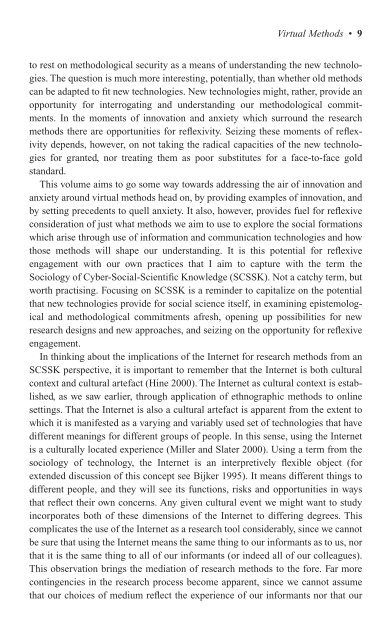Virtual Methods
Virtual Methods
Virtual Methods
Create successful ePaper yourself
Turn your PDF publications into a flip-book with our unique Google optimized e-Paper software.
<strong>Virtual</strong> <strong>Methods</strong> • 9<br />
to rest on methodological security as a means of understanding the new technologies.<br />
The question is much more interesting, potentially, than whether old methods<br />
can be adapted to fit new technologies. New technologies might, rather, provide an<br />
opportunity for interrogating and understanding our methodological commitments.<br />
In the moments of innovation and anxiety which surround the research<br />
methods there are opportunities for reflexivity. Seizing these moments of reflexivity<br />
depends, however, on not taking the radical capacities of the new technologies<br />
for granted, nor treating them as poor substitutes for a face-to-face gold<br />
standard.<br />
This volume aims to go some way towards addressing the air of innovation and<br />
anxiety around virtual methods head on, by providing examples of innovation, and<br />
by setting precedents to quell anxiety. It also, however, provides fuel for reflexive<br />
consideration of just what methods we aim to use to explore the social formations<br />
which arise through use of information and communication technologies and how<br />
those methods will shape our understanding. It is this potential for reflexive<br />
engagement with our own practices that I aim to capture with the term the<br />
Sociology of Cyber-Social-Scientific Knowledge (SCSSK). Not a catchy term, but<br />
worth practising. Focusing on SCSSK is a reminder to capitalize on the potential<br />
that new technologies provide for social science itself, in examining epistemological<br />
and methodological commitments afresh, opening up possibilities for new<br />
research designs and new approaches, and seizing on the opportunity for reflexive<br />
engagement.<br />
In thinking about the implications of the Internet for research methods from an<br />
SCSSK perspective, it is important to remember that the Internet is both cultural<br />
context and cultural artefact (Hine 2000). The Internet as cultural context is established,<br />
as we saw earlier, through application of ethnographic methods to online<br />
settings. That the Internet is also a cultural artefact is apparent from the extent to<br />
which it is manifested as a varying and variably used set of technologies that have<br />
different meanings for different groups of people. In this sense, using the Internet<br />
is a culturally located experience (Miller and Slater 2000). Using a term from the<br />
sociology of technology, the Internet is an interpretively flexible object (for<br />
extended discussion of this concept see Bijker 1995). It means different things to<br />
different people, and they will see its functions, risks and opportunities in ways<br />
that reflect their own concerns. Any given cultural event we might want to study<br />
incorporates both of these dimensions of the Internet to differing degrees. This<br />
complicates the use of the Internet as a research tool considerably, since we cannot<br />
be sure that using the Internet means the same thing to our informants as to us, nor<br />
that it is the same thing to all of our informants (or indeed all of our colleagues).<br />
This observation brings the mediation of research methods to the fore. Far more<br />
contingencies in the research process become apparent, since we cannot assume<br />
that our choices of medium reflect the experience of our informants nor that our



